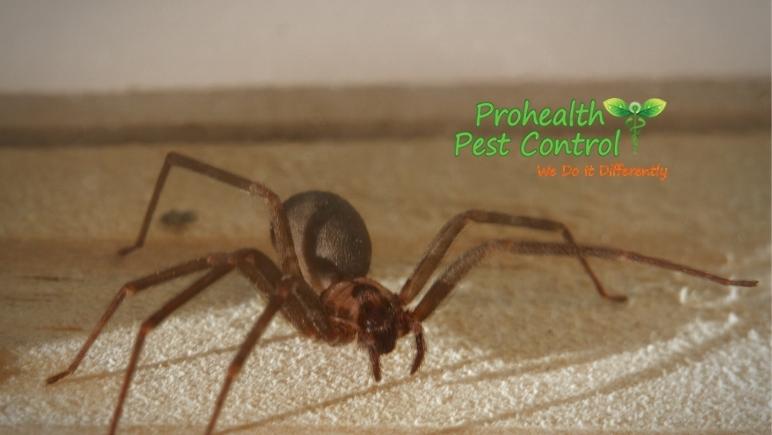Do you have a full-blown brown recluse infestation in your home?
Although most people in the United States don’t have to worry too much about exposure to venomous spiders, brown recluse spiders are definitely one to watch out for.
If you see any signs of a brown recluse infestation, then it’s important that you act right away. To help you be sure, we’re going to cover some important facts about these spiders and what you can do about them.
Why Brown Recluse Spiders Are a Concern
Although spider bites from any such arachnid can hurt, most are harmless and result in nothing more than a little pain and some redness.
A bite from a brown recluse spider is far worse. Their bites are venomous and can cause severe damage to surrounding tissue. This can sometimes result in muscle pain, fever, and convulsions.
Their bite is not fatal to humans, but those who are most vulnerable are children, seniors, and anyone who suffers from immune system disorders. Their bite has also been known to be fatal to small dogs and other small animals.
How to Identify a Brown Recluse Spider
Even if you’re a very healthy individual, you don’t want to deal with a brown recluse spider infestation. Therefore, it’s important you’re able to identify a brown recluse if you happen to come across one.
Here are a few details that will help you identify this species:
- Color — As you can infer from the name, these spiders are light or dark brown, but may also be yellowish. If you see a spider with stripes on its legs, that isn’t a recluse.
- Markings — While it’s true that brown recluse spiders have a violin-shaped marking on their thorax, it’s too faint to see. If you can see it, you’re way too close!
- Size — The size of a brown recluse’s body is only around one-half inch or less. Keep in mind that this doesn’t include the legs…
- Location — Although more prevalent in the Southwest, infestations have been reported in Florida. They’re found in undisturbed areas such as in boxes, crawlspaces, basements, closets, and even shoes.
5 Signs of a Brown Recluse Infestation
Knowing what a brown recluse spider looks like and where you’re likely to find them is only part of the solution. You also need to identify clues that you may find or experience around your home.
Here are five signs of a brown recluse infestation to watch out for:
- Actual Sighting — If you see a brown recluse walking around, this is a problem. A sighting usually occurs if you’re searching through one of their common locations, such as a closet or basement.
- Corner Webs — Like most spiders, a brown recluse will build a web to catch its prey. The existence of a corner web can point to other spiders as well.
- Egg Sac — A recluse’s silken egg sac is off-white, round, and approximately 5/8 inch. A typical egg sac will hold dozens of spiders, so if you see one, dispose of it.
- Blisters and Pain – A brown recluse spider bite is painful and causes redness to the area. You may also experience damaged tissue around the spot where you were bitten.
- Sick Dog — A bite can be fatal to small dogs, but larger dogs can also get very sick. If a dog in your house gets ill, a brown recluse may be the culprit.
Importance of Professional Spider Control
Whether you have a brown recluse spider infestation or only find one or two of them, the danger they impose makes it wise to call a pest control company right away. This will help you avoid injury and may prevent two or three spiders from becoming a full-blown infestation.
Tactics to Avoid Brown Recluse Spiders
The most important thing to remember about brown recluse spiders is that they’re often attracted to your home for the same reasons as other pests.
If you want to avoid a brown recluse infestation, then you need to take a few easy-to-follow measures.
Here are some simple tactics that you can use to keep these spiders away from your home:
- Always Keep an Eye Out — To prevent a potential brown recluse infestation, you always want to keep an eye out for them. Since these spiders hide in out-of-the-way spots or in areas that aren’t used too often, be especially mindful when moving items around.
- Remove Water Sources — Like other pests, brown recluse spiders are attracted to any place where they can find water. Removing water sources such as pools of water following a rainstorm can go a long way to making your home less attractive.
- Seal Off Entry Points — While brown recluse adults aren’t tiny, all sizes of these spiders can squeeze within cracks and gaps found in your home. Seal off these areas around your doors and windows, inside your attic or basement, along your foundation, etc. with weather-stripping, spray foam, or caulk.
- Trim Back Vegetation — Traveling among vegetation is a common way for brown recluse spiders to get inside your home. Keep trees, bushes, and other vegetation trimmed back.
- Remove Food Sources — In the case of brown recluse spiders, their food source will be insects. You can keep these arachnids at bay by controlling the number of insects in and around your home. Professional pest control services are your best option.
- Check Clothes and Shoes — If you tend to leave clothes and shoes laying around for long periods, you may discover a brown recluse among them. Be sure to check any unused items before use to prevent being bitten.
Contact ProHealth Pest Control for Signs of a Brown Recluse Infestation
If you discover any signs of a brown recluse infestation, then it’s time to call the professionals at ProHealth Pest Control. To learn more about pest prevention or to set up an appointment for pest control services, give us a call at (727) 310-0521 today to schedule a free consultation for spider control.





